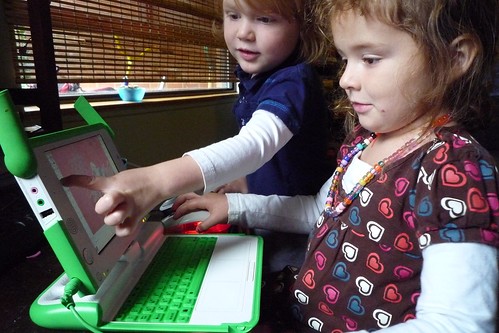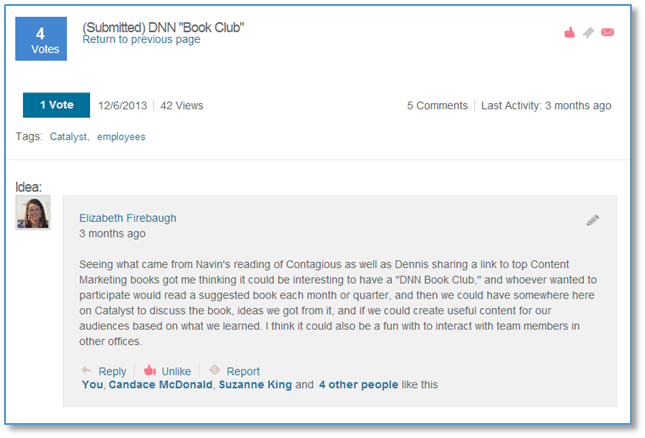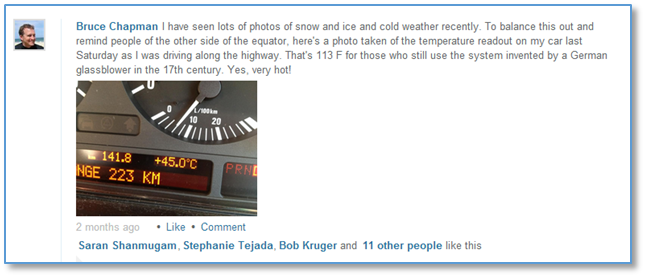The Impact of an Internal Online Community

Photo source: Tim & Selena Middleton on
flickr.
“What do you want to be when you grow up?”
I can remember being asked that more than a
few times as a child, and probably more recently than I care to admit.
When I was a kid, it seemed simple. There were the obvious choices: a doctor, a
lawyer, a nurse, a teacher, a police officer; and there were the slightly more
out-of-the-box answers: an artist, an astronaut, a rock star, or a marine
biologist.
At least those
were the answers when I was growing up. Now, it might be different. A YouTube sensation? A developer of the next great iPhone app? A Facebook employee? It seems like it’s
not just the answers
that are changing, but also the questions, as more and more, it isn’t just what
you want to do, but how, where, and when you want to do it.
The Changing Nature of Work

Photo source: User wrumsby on
flickr.
As a remote employee for DNN, one thing that particularly
interests me is the changing nature of work: and not just the job, but more so
the
environment in which work is done. It used to be that most people went to their company offices and worked
from 9:00 am to 5:00 pm, and although that may still be the case for some, more
and more companies are recognizing that as diverse as their employees are, the
environments in which these workers thrive also vary.
I’m not a morning
person, and in a previous job, my manager’s attention to arriving in the office
by 8:30 am on the dot was a source of frustration.When I’d work late, and most often alone in
the office, I was more productive, so why did I need to be there at exactly
8:30 in the morning?
An increasing number of employers allow their workers to
have flexible hours, in part due to the increasing demands for employees to be
available outside of traditional business hours. Often receiving work email to their smart
phones, employees not only can stay connected outside of the office, but are
expected to stay connected.
With the rise of social networks like Facebook,
Twitter and Instagram,
people increasingly demand immediate
gratification. Business is global and a
time difference isn’t always an adequate reason for not receiving a quick
response.
A Distributed Workforce

Photo source: Mike McCune on
flickr.
One large advantage of this globalization, however, is the
ability for companies to
hire the most qualified candidates, regardless of
geography
. For example, DNN has offices
in Langley, British Columbia, and San Mateo, California, but also employs workers who work
remotely from cities in Kentucky, Virginia, South Carolina, and Georgia, as
well as Australia, the Canary Islands, and Europe.
Since joining DNN in August, I’ve had the
opportunity to work with and get to know many of these people from across the United
States and across the globe. By not
being restricted by location, DNN has been able to hire skilled and passionate
employees who are often leading teams to create, sell, and support our exciting
product line,
products that would not be the same without these employees, and thus
would not be the same without such a geographically diverse workforce.
Expectations of Today's Workers
Flexible hours and the globalization of the workforce (and
customer base) are only a few trends in the changing work environment. Companies are also recognizing the importance
of providing creative and comfortable spaces for their workers and are building
a sense of community among them by sponsoring team-building activities during
business hours.

As a new generation of workers think not only about what
they want to do, but how, when, and where they want to do it, it becomes increasingly
important to think about how these businesses will communicate internally, and DNN
understands that. With employees located
in such diverse locations, it is important to offer a centralized way of
communicating knowledge and building a strong corporate culture. For DNN, there was no better way to do that
than through our own
online community solution, Evoq Social.
Our Intranet at DNN
Evoq Social powers DNN’s intranet, Catalyst, which has become the hub of communication within our company. Sales, marketing, product, and engineering
team members post updates, ask questions, upload documents, and share ideas
with each other, essentially creating a searchable knowledge base for everyone
in the organization.
Sharing ideas
is an important element of Evoq Social, and at DNN, the sharing and discussing
of ideas is encouraged by management and facilitated through Catalyst. We allow all employees to submit ideas, which can then be voted and commented on
by other members of the DNN team.Once
an idea receives a certain number of votes, it is more formally discussed by
management.Earlier this year, I
proposed an idea for a DNN Employee Book Club.

Although the idea didn’t exactly take off, you can see that
it received a few votes and likes. But
the important part here is not whether my idea came to fruition, it’s that I
had the
ability to easily share my idea, that others could discuss it, and that
ideas created, shared, and voted on by employees are thoughtfully considered by
management. Employees are empowered in
knowing they have a voice, a voice that can be heard whether sitting at a desk
ten feet from the CEO, or across an ocean from him.
To read more about an idea that did take
off, check a post from my colleague Megan:
Helping
a Family During the 2013 Holiday Season
Increasing Our Organizational IQ

Photo source: Jay Gooby on
flickr.
Catalyst also provides an opportunity to ask questions of
each other. Using a
Q&A feature, employees submit questions, which can then be answered by others. Answers are up- or down-voted by end users. Recently, a co-worker asked a question about how
to generate more reviews of products on the
DNN
Store.
As the DNN Store Manager, this employee could have emailed or called me directly to get
more information; however, that conversation and that information would have
stayed only between him and me. On the
other hand, he posted the question to Catalyst; I was able to share our current
efforts, and several others chimed in with their ideas.
Within a company, or any community, the
experiences and expertise of the group are greater than that of a few individuals. Q&A allows
knowledge to be easily collected from many and shared with many. This is not so easily done through email or
phone conversations, which can be even harder to coordinate across time
zones. In the example above, key members
of the conversation were located in California, South Carolina, Australia, and
Amsterdam.
Sharing Stories
In all honesty, I am not among the most frequent
contributors to the content on our intranet; however
I am a daily consumer of
this content. I primarily work with a
pretty specific area of our company, and the time I spend on Catalyst helps me
stay informed of what is going on in sales, marketing, product development, and
other areas of the company.
We all
joined in the excitement when a sales engineer recently shared feedback from a
successful training, or in seeing news about an upcoming release, but we don’t
just share the good news. For example, learning
of less positive feedback provided by a customer is just as beneficial, and we
discuss important questions around that feedback:
Have we
heard this before?
What are some
solutions?
How do we move forward?
Through conversations like these, whether as
a participant or a reader, the group as a whole is reaffirmed of our
commitment
to growth, improvement, and customer satisfaction.
But beyond the business uses, I would say that the
connections that are created across teams and locations are just as
important. As a remote employee,
I don’t have the opportunity to come to the office and interact with others on
a daily basis, so Catalyst has helped me get to know the team I work with.

I read blogs about DNN’s intramural soccer
team. A co-worker recently shared
pictures of his wedding. There was a little
friendly banter over who would win the Super Bowl, as well as who would claim
victory during the USA/Canada Olympic hockey games. When it was snowing in Canada, our Australian
co-worker reminded us it was hot and sunny in his neck of the woods.
Conclusion
And although these things might seem trivial to some, there
are few that would argue that a work culture where co-workers are personally
connected fosters
open and honest communication regarding work-related matters, builds loyalty to
each other and to the team, and makes us even more passionate about
contributing to the success of our company.
Sound like something you can get on board with?
Try Evoq Social out for
yourself!